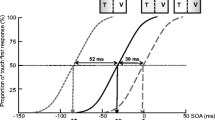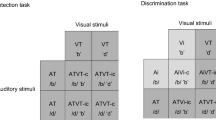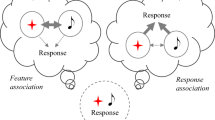Abstract
Stimuli occurring in multiple sensory modalities that are temporally synchronous or spatially coincident can be integrated together to enhance perception. Additionally, the semantic content or meaning of a stimulus can influence cross-modal interactions, improving task performance when these stimuli convey semantically congruent or matching information, but impairing performance when they contain non-matching or distracting information. Attention is one mechanism that is known to alter processing of sensory stimuli by enhancing perception of task-relevant information and suppressing perception of task-irrelevant stimuli. It is not known, however, to what extent attention to a single sensory modality can minimize the impact of stimuli in the unattended sensory modality and reduce the integration of stimuli across multiple sensory modalities. Our hypothesis was that modality-specific selective attention would limit processing of stimuli in the unattended sensory modality, resulting in a reduction of performance enhancements produced by semantically matching multisensory stimuli, and a reduction in performance decrements produced by semantically non-matching multisensory stimuli. The results from two experiments utilizing a cued discrimination task demonstrate that selective attention to a single sensory modality prevents the integration of matching multisensory stimuli that is normally observed when attention is divided between sensory modalities. Attention did not reliably alter the amount of distraction caused by non-matching multisensory stimuli on this task; however, these findings highlight a critical role for modality-specific selective attention in modulating multisensory integration.




Similar content being viewed by others
References
Alsius A, Navarra J, Campbell R, Soto-Faraco S (2005) Audiovisual integration of speech falters under high attention demands. Curr Biol 15:839–843
Bertelson P, Radeau M (1981) Cross-modal bias and perceptual fusion with auditory-visual spatial discordance. Percept Psychophys 29:578–584
Bertelson P, Vroomen J, de Gelder B, Driver J (2000) The ventriloquist effect does not depend on the direction of deliberate visual attention. Percept Psychophys 62:321–332
Burnett LR, Stein BE, Chaponis D, Wallace MT (2004) Superior colliculus lesions preferentially disrupt multisensory orientation. Neuroscience 124:535–547
Calvert GA, Campbell R, Brammer MJ (2000) Evidence from functional magnetic resonance imaging of crossmodal binding in the human heteromodal cortex. Curr Biol 10:649–657
Corbetta M, Miezin FM, Dobmeyer S, Shulman GL, Petersen SE (1990) Attentional modulation of neural processing of shape, color, and velocity in humans. Science 248:1556–1559
Craik FI, Govoni R, Naveh-Benjamin M, Anderson ND (1996) The effects of divided attention on encoding and retrieval processes in human memory. J Exp Psychol Gen 125:159–180
Egner T, Hirsch J (2005) Cognitive control mechanisms resolve conflict through cortical amplification of task-relevant information. Nat Neurosci 8:1784–1790
Fan J, Flombaum JI, McCandliss BD, Thomas KM, Posner MI (2003) Cognitive and brain consequences of conflict. Neuroimage 18:42–57
Haxby JV, Horwitz B, Ungerleider LG, Maisog JM, Pietrini P, Grady CL (1994) The functional organization of human extrastriate cortex: a PET-rCBF study of selective attention to faces and locations. J Neurosci 14:6336–6353
Hershenson M (1962) Reaction time as a measure of intersensory facilitation. J Exp Psychol 63:289–293
Jiang W, Jiang H, Stein BE (2002) Two corticotectal areas facilitate multisensory orientation behavior. J Cogn Neurosci 14:1240–1255
Johnen A, Wagner H, Gaese BH (2001) Spatial attention modulates sound localization in barn owls. J Neurophysiol 85:1009–1012
Johnson JA, Zatorre RJ (2005) Attention to simultaneous unrelated auditory and visual events: behavioral and neural correlates. Cereb Cortex 15:1609–1620
Johnson JA, Zatorre RJ (2006) Neural substrates for dividing and focusing attention between simultaneous auditory and visual events. Neuroimage 31:1673–1681
Kastner S, De Weerd P, Desimone R, Ungerleider LG (1998) Mechanisms of directed attention in the human extrastriate cortex as revealed by functional MRI. Science 282:108–111
Kawashima R, O’Sullivan BT, Roland PE (1995) Positron-emission tomography studies of cross-modality inhibition in selective attentional tasks: closing the “mind’s eye”. Proc Natl Acad Sci USA 92:5969–5972
Laurienti PJ, Burdette JH, Wallace MT, Yen YF, Field AS, Stein BE (2002) Deactivation of sensory-specific cortex by cross-modal stimuli. J Cogn Neurosci 14:420–429
Laurienti PJ, Kraft RA, Maldjian JA, Burdette JH, Wallace MT (2004) Semantic congruence is a critical factor in multisensory behavioral performance. Exp Brain Res 158:405–414
Laurienti PJ, Burdette JH, Maldjian JA, Wallace MT (2006) Enhanced multisensory integration in older adults. Neurobiol Aging 27:1155–1163
Loose R, Kaufmann C, Auer DP, Lange KW (2003) Human prefrontal and sensory cortical activity during divided attention tasks. Hum Brain Mapp 18:249–259
Macaluso E, Frith CD, Driver J (2000) Modulation of human visual cortex by crossmodal spatial attention. Science 289:1206–1208
Macaluso E, Frith CD, Driver J (2002) Directing attention to locations and to sensory modalities: multiple levels of selective processing revealed with PET. Cereb Cortex 12:357–368
Macaluso E, George N, Dolan R, Spence C, Driver J (2004) Spatial and temporal factors during processing of audiovisual speech: a PET study. Neuroimage 21:725–732
McDonald JJ, Teder-Salejarvi WA, Di Russo F, Hillyard SA (2003) Neural substrates of perceptual enhancement by cross-modal spatial attention. J Cogn Neurosci 15:10–19
Miller J (1982) Divided attention: evidence for coactivation with redundant signals. Cognit Psychol 14:247–279
Miller J (1986) Timecourse of coactivation in bimodal divided attention. Percept Psychophys 40:331–343
Moore CM, Egeth H (1998) How does feature-based attention affect visual processing? J Exp Psychol Hum Percept Perform 24:1296–1310
Morrell LK (1968) Temporal characteristics of sensory interaction in choice reaction times. J Exp Psychol 77:14–18
Motter BC (1993) Focal attention produces spatially selective processing in visual cortical areas V1, V2, and V4 in the presence of competing stimuli. J Neurophysiol 70:909–919
O’Leary DS, Andreasen NC, Hurtig RR, Torres IJ, Flashman LA, Kesler ML, Arndt SV, Cizadlo TJ, Ponto LLB, Watkins GL, Hichwa RD (1997) Auditory and visual attention assessed with PET. Hum Brain Mapp 5:422–436
Poliakoff E, Ashworth S, Lowe C, Spence C (2006) Vision and touch in ageing: crossmodal selective attention and visuotactile spatial interactions. Neuropsychologia 44:507–517
Posner MI, Driver J (1992) The neurobiology of selective attention. Curr Opin Neurobiol 2:165–169
Rees G, Frith C, Lavie N (2001) Processing of irrelevant visual motion during performance of an auditory attention task. Neuropsychologia 39:937–949
Reynolds JH, Chelazzi L, Desimone R (1999) Competitive mechanisms subserve attention in macaque areas V2 and V4. J Neurosci 19:1736–1753
Shore DI, Simic N (2005) Integration of visual and tactile stimuli: top–down influences require time. Exp Brain Res 166:509–517
Spence C, Driver J (1997) On measuring selective attention to an expected sensory modality. Percept Psychophys 59:389–403
Spence C, Nicholls ME, Gillespie N, Driver J (1998) Cross-modal links in exogenous covert spatial orienting between touch, audition, and vision. Percept Psychophys 60:544–557
Spence C, Nicholls ME, Driver J (2001) The cost of expecting events in the wrong sensory modality. Percept Psychophys 63:330–336
Spitzer H, Desimone R, Moran J (1988) Increased attention enhances both behavioral and neuronal performance. Science 240:338–340
Stein BE, Meredith MA, Huneycutt WS, McDade L (1989) Behavioral indices of multisensory integration: orientation to visual cues is affected by auditory stimuli. J Cogn Neurosci 1:12–24
Talsma D, Kok A (2001) Nonspatial intermodal selective attention is mediated by sensory brain areas: evidence from event-related potentials. Psychophysiology 38:736–751
Talsma D, Woldorff MG (2005) Selective attention and multisensory integration: multiple phases of effects on the evoked brain activity. J Cogn Neurosci 17:1098–1114
Talsma D, Doty TJ, Woldorff MG (2007) Selective attention and audiovisual integration: is attending to both modalities a prerequisite for early integration? Cereb Cortex 17:679–690
Turatto M, Benso F, Galfano G, Umilta C (2002) Nonspatial attentional shifts between audition and vision. J Exp Psychol Hum Percept Perform 28:628–639
Turatto M, Galfano G, Bridgeman B, Umilta C (2004) Space-independent modality-driven attentional capture in auditory, tactile and visual systems. Exp Brain Res 155:301–310
Vroomen J, Bertelson P, de Gelder B (2001) The ventriloquist effect does not depend on the direction of automatic visual attention. Percept Psychophys 63:651–659
Weissman DH, Giesbrecht B, Song AW, Mangun GR, Woldorff MG (2003) Conflict monitoring in the human anterior cingulate cortex during selective attention to global and local object features. Neuroimage 19:1361–1368
Woodruff PW, Benson RR, Bandettini PA, Kwong KK, Howard RJ, Talavage T, Belliveau J, Rosen BR (1996) Modulation of auditory and visual cortex by selective attention is modality-dependent. Neuroreport 7:1909–1913
Acknowledgments
We would like to thank Ms Elizabeth Bennett for her assistance with data collection and analyses. This research was supported by NIH grant #NS042568.
Author information
Authors and Affiliations
Corresponding author
Rights and permissions
About this article
Cite this article
Mozolic, J.L., Hugenschmidt, C.E., Peiffer, A.M. et al. Modality-specific selective attention attenuates multisensory integration. Exp Brain Res 184, 39–52 (2008). https://doi.org/10.1007/s00221-007-1080-3
Received:
Accepted:
Published:
Issue Date:
DOI: https://doi.org/10.1007/s00221-007-1080-3




